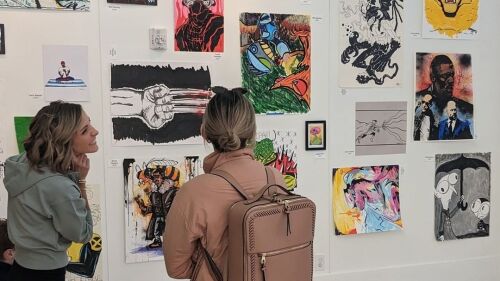Eccentric, free-spirited, charismatic. That’s how many would describe the larger-than-life presence of poet and artist Henry Faulkner.
To celebrate and honor the colorful Lexingtonian, the Headley-Whitney Museum is currently selling the book, “Henry Faulkner Centennial Celebration,” a catalogue featuring ~200 pieces of his work that were donated by the community for the previous exhibit.
Celebrate Faulkner
Here’s a few fast facts about the book:
- Available in the museum gift shop
- Hours: Friday-Sunday, 10 a.m. to 4 p.m.
- Cost for a soft cover copy is $60
Faulkner’s life was known to be as animated as his own work. We spoke with his friend + gallery owner John Hockensmith to discuss his impact on the local art community — as well as the legend of his supposed bourbon-drinking goat Alice.
Tell us about your personal connection to Henry
“When I was a young lad in my early 20s, I was like the rest of the community. We were all awestruck by Henry’s stature in the world. When I met him, he asked me what do I do...I had just started a frame shop in Georgetown.”
In 1978, John became the go-to guy for framing Henry’s early work, his “celebrity photographer,” and would soon be displaying his photography alongside Henry’s paintings.
“Henry employed everybody. Everybody worked for Henry and his mind.”
Even after Henry died in a car accident in 1981, John says, “My connection never went away.” He went on to contribute to the biography, “The Outrageous Life of Henry Faulkner” and the chronological art book, “The Gift of Color: Henry Lawrence Faulkner.”
He kept returning to your life after he passed. It’s almost like he was a guardian angel.
John laughs and adds, “Also a guardian devil. He was a complex man.”
Many people describe him as this bohemian, free-spirited person. Do you think that his life imitated his art? Or vice versa?
“Henry was art. I don’t know that I could begin to distinguish the person from the creativity. Even in the impetuousness of slamming on the brakes, pulling over in a ditch, and jumping out to pick wildflowers. He authentically lived art...He couldn’t escape that.”
According to John, “The Headley-Whitney collection reflects the joy of Henry’s paintings.”
Describe his impact on the local community in three words.
“Pied piper of Lexington...He was an iconic Lexingtonian.”
John makes a point to dispel that “outlandish” rumors of Henry’s bourbon-drinking goat. While the stories around Henry certainly make for juicy urban myths, the real life of the artist didn’t need any amplification. John remembers who he was at the core: an openly gay man who valued the back-to-the-land lifestyle, contemplated life’s complexities, and lived as a spontaneous, bona fide creative.














